NRSG370 - Clinical Integration: Jack Buun Femoral Fracture Care
VerifiedAdded on 2023/06/10
|7
|2118
|343
Case Study
AI Summary
This case study focuses on the post-operative care of Jack Buun, a 69-year-old male who suffered a femoral neck fracture after a fall. The analysis covers his initial presentation, surgical intervention (hemiarthroplasty), and post-operative management, including pain management with medications like Morphine, Tramadol, Paracoxib, and Paracetamol. The case study discusses potential perioperative issues common in elderly patients, such as polypharmacy and post-operative complications. It emphasizes the importance of early mobilization, respiratory exercises, and careful fluid and electrolyte management to prevent complications like pneumonia and deep vein thrombosis. The analysis also reviews the medications administered, noting potential adverse effects and recommending alternative approaches. Furthermore, it suggests preventative measures such as home safety assessments and assistive devices to minimize the risk of future falls, highlighting the need for comprehensive and patient-centered care.

Running head: JACK BUUN 1
JACK BUUN
Student ID Number
Affiliation
JACK BUUN
Student ID Number
Affiliation
Paraphrase This Document
Need a fresh take? Get an instant paraphrase of this document with our AI Paraphraser
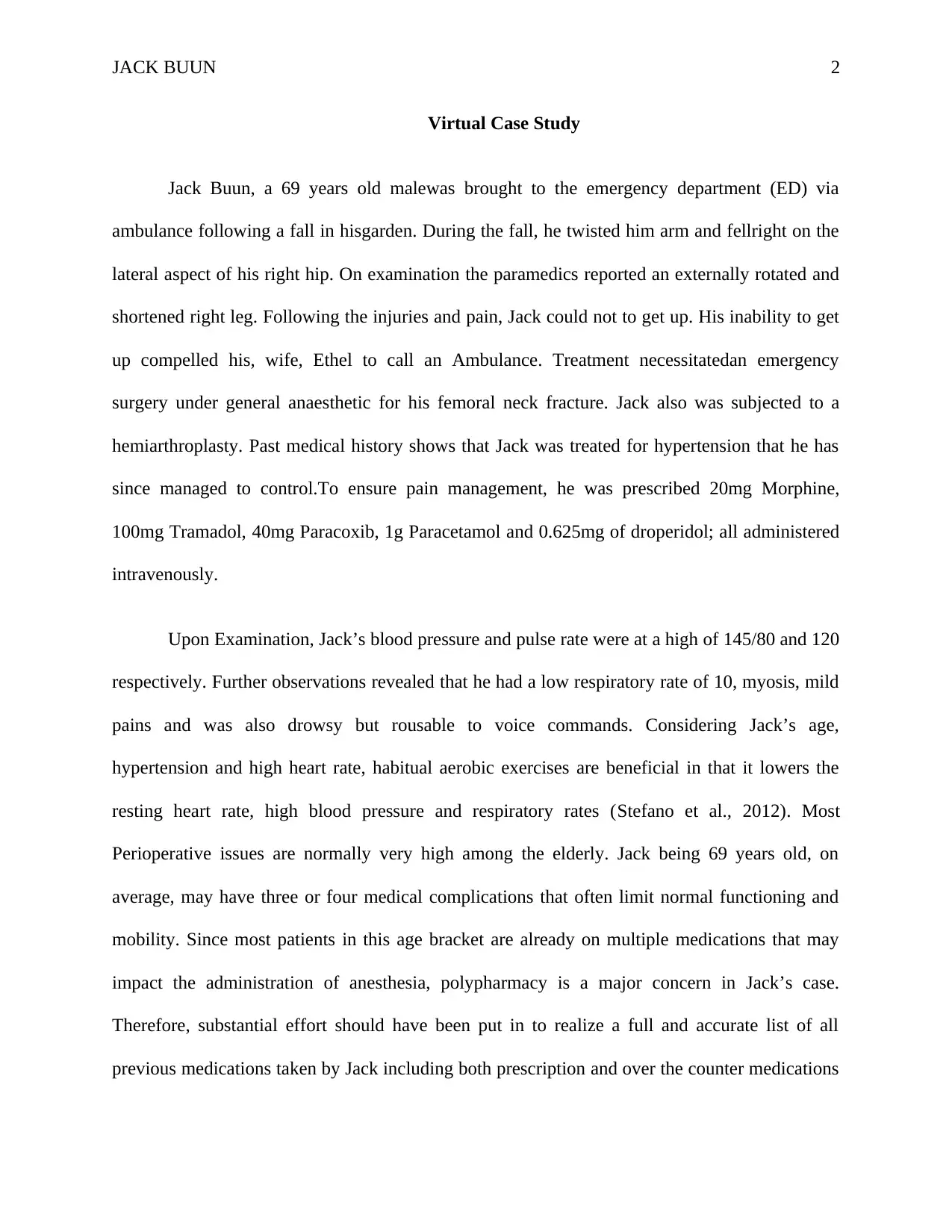
JACK BUUN 2
Virtual Case Study
Jack Buun, a 69 years old malewas brought to the emergency department (ED) via
ambulance following a fall in hisgarden. During the fall, he twisted him arm and fellright on the
lateral aspect of his right hip. On examination the paramedics reported an externally rotated and
shortened right leg. Following the injuries and pain, Jack could not to get up. His inability to get
up compelled his, wife, Ethel to call an Ambulance. Treatment necessitatedan emergency
surgery under general anaesthetic for his femoral neck fracture. Jack also was subjected to a
hemiarthroplasty. Past medical history shows that Jack was treated for hypertension that he has
since managed to control.To ensure pain management, he was prescribed 20mg Morphine,
100mg Tramadol, 40mg Paracoxib, 1g Paracetamol and 0.625mg of droperidol; all administered
intravenously.
Upon Examination, Jack’s blood pressure and pulse rate were at a high of 145/80 and 120
respectively. Further observations revealed that he had a low respiratory rate of 10, myosis, mild
pains and was also drowsy but rousable to voice commands. Considering Jack’s age,
hypertension and high heart rate, habitual aerobic exercises are beneficial in that it lowers the
resting heart rate, high blood pressure and respiratory rates (Stefano et al., 2012). Most
Perioperative issues are normally very high among the elderly. Jack being 69 years old, on
average, may have three or four medical complications that often limit normal functioning and
mobility. Since most patients in this age bracket are already on multiple medications that may
impact the administration of anesthesia, polypharmacy is a major concern in Jack’s case.
Therefore, substantial effort should have been put in to realize a full and accurate list of all
previous medications taken by Jack including both prescription and over the counter medications
Virtual Case Study
Jack Buun, a 69 years old malewas brought to the emergency department (ED) via
ambulance following a fall in hisgarden. During the fall, he twisted him arm and fellright on the
lateral aspect of his right hip. On examination the paramedics reported an externally rotated and
shortened right leg. Following the injuries and pain, Jack could not to get up. His inability to get
up compelled his, wife, Ethel to call an Ambulance. Treatment necessitatedan emergency
surgery under general anaesthetic for his femoral neck fracture. Jack also was subjected to a
hemiarthroplasty. Past medical history shows that Jack was treated for hypertension that he has
since managed to control.To ensure pain management, he was prescribed 20mg Morphine,
100mg Tramadol, 40mg Paracoxib, 1g Paracetamol and 0.625mg of droperidol; all administered
intravenously.
Upon Examination, Jack’s blood pressure and pulse rate were at a high of 145/80 and 120
respectively. Further observations revealed that he had a low respiratory rate of 10, myosis, mild
pains and was also drowsy but rousable to voice commands. Considering Jack’s age,
hypertension and high heart rate, habitual aerobic exercises are beneficial in that it lowers the
resting heart rate, high blood pressure and respiratory rates (Stefano et al., 2012). Most
Perioperative issues are normally very high among the elderly. Jack being 69 years old, on
average, may have three or four medical complications that often limit normal functioning and
mobility. Since most patients in this age bracket are already on multiple medications that may
impact the administration of anesthesia, polypharmacy is a major concern in Jack’s case.
Therefore, substantial effort should have been put in to realize a full and accurate list of all
previous medications taken by Jack including both prescription and over the counter medications
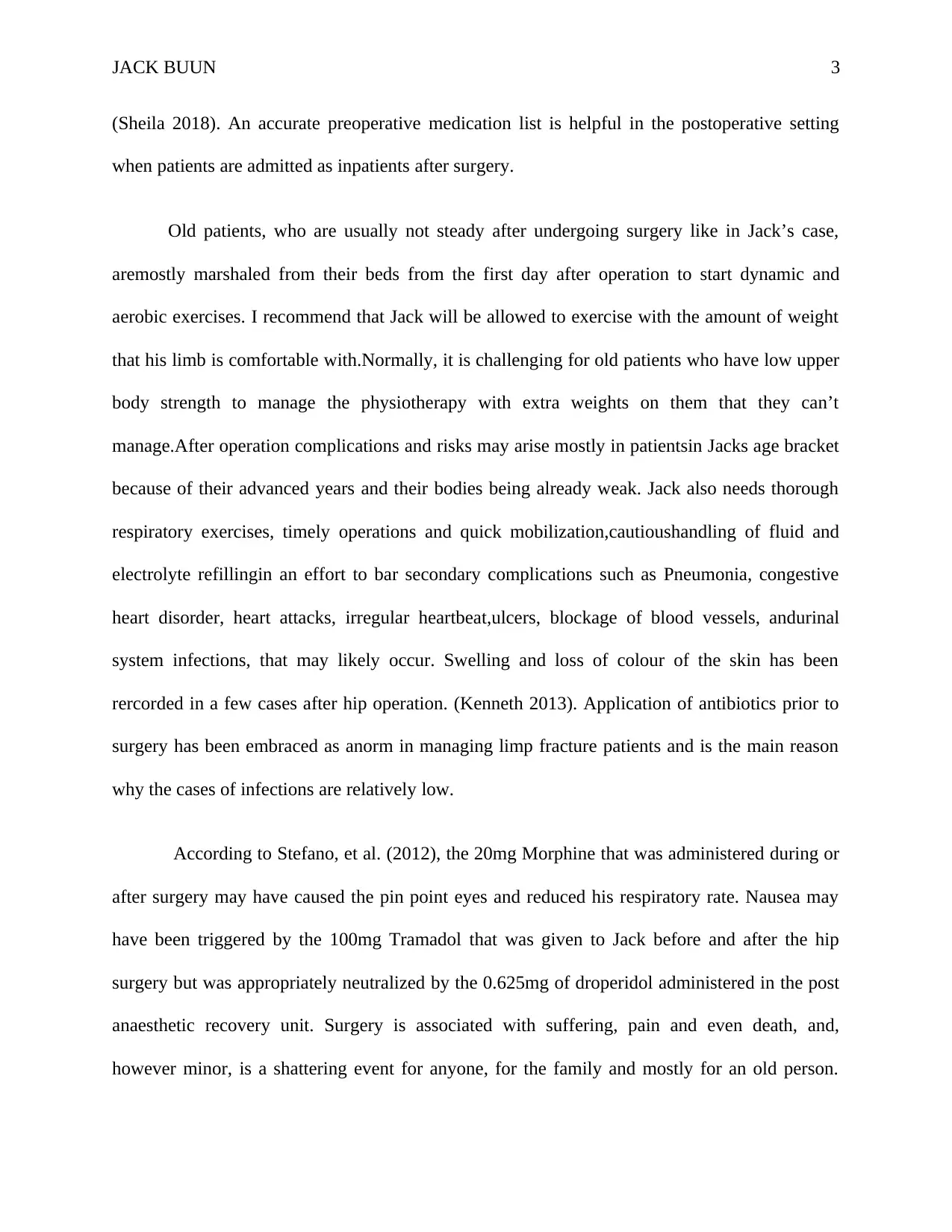
JACK BUUN 3
(Sheila 2018). An accurate preoperative medication list is helpful in the postoperative setting
when patients are admitted as inpatients after surgery.
Old patients, who are usually not steady after undergoing surgery like in Jack’s case,
aremostly marshaled from their beds from the first day after operation to start dynamic and
aerobic exercises. I recommend that Jack will be allowed to exercise with the amount of weight
that his limb is comfortable with.Normally, it is challenging for old patients who have low upper
body strength to manage the physiotherapy with extra weights on them that they can’t
manage.After operation complications and risks may arise mostly in patientsin Jacks age bracket
because of their advanced years and their bodies being already weak. Jack also needs thorough
respiratory exercises, timely operations and quick mobilization,cautioushandling of fluid and
electrolyte refillingin an effort to bar secondary complications such as Pneumonia, congestive
heart disorder, heart attacks, irregular heartbeat,ulcers, blockage of blood vessels, andurinal
system infections, that may likely occur. Swelling and loss of colour of the skin has been
rercorded in a few cases after hip operation. (Kenneth 2013). Application of antibiotics prior to
surgery has been embraced as anorm in managing limp fracture patients and is the main reason
why the cases of infections are relatively low.
According to Stefano, et al. (2012), the 20mg Morphine that was administered during or
after surgery may have caused the pin point eyes and reduced his respiratory rate. Nausea may
have been triggered by the 100mg Tramadol that was given to Jack before and after the hip
surgery but was appropriately neutralized by the 0.625mg of droperidol administered in the post
anaesthetic recovery unit. Surgery is associated with suffering, pain and even death, and,
however minor, is a shattering event for anyone, for the family and mostly for an old person.
(Sheila 2018). An accurate preoperative medication list is helpful in the postoperative setting
when patients are admitted as inpatients after surgery.
Old patients, who are usually not steady after undergoing surgery like in Jack’s case,
aremostly marshaled from their beds from the first day after operation to start dynamic and
aerobic exercises. I recommend that Jack will be allowed to exercise with the amount of weight
that his limb is comfortable with.Normally, it is challenging for old patients who have low upper
body strength to manage the physiotherapy with extra weights on them that they can’t
manage.After operation complications and risks may arise mostly in patientsin Jacks age bracket
because of their advanced years and their bodies being already weak. Jack also needs thorough
respiratory exercises, timely operations and quick mobilization,cautioushandling of fluid and
electrolyte refillingin an effort to bar secondary complications such as Pneumonia, congestive
heart disorder, heart attacks, irregular heartbeat,ulcers, blockage of blood vessels, andurinal
system infections, that may likely occur. Swelling and loss of colour of the skin has been
rercorded in a few cases after hip operation. (Kenneth 2013). Application of antibiotics prior to
surgery has been embraced as anorm in managing limp fracture patients and is the main reason
why the cases of infections are relatively low.
According to Stefano, et al. (2012), the 20mg Morphine that was administered during or
after surgery may have caused the pin point eyes and reduced his respiratory rate. Nausea may
have been triggered by the 100mg Tramadol that was given to Jack before and after the hip
surgery but was appropriately neutralized by the 0.625mg of droperidol administered in the post
anaesthetic recovery unit. Surgery is associated with suffering, pain and even death, and,
however minor, is a shattering event for anyone, for the family and mostly for an old person.
⊘ This is a preview!⊘
Do you want full access?
Subscribe today to unlock all pages.

Trusted by 1+ million students worldwide
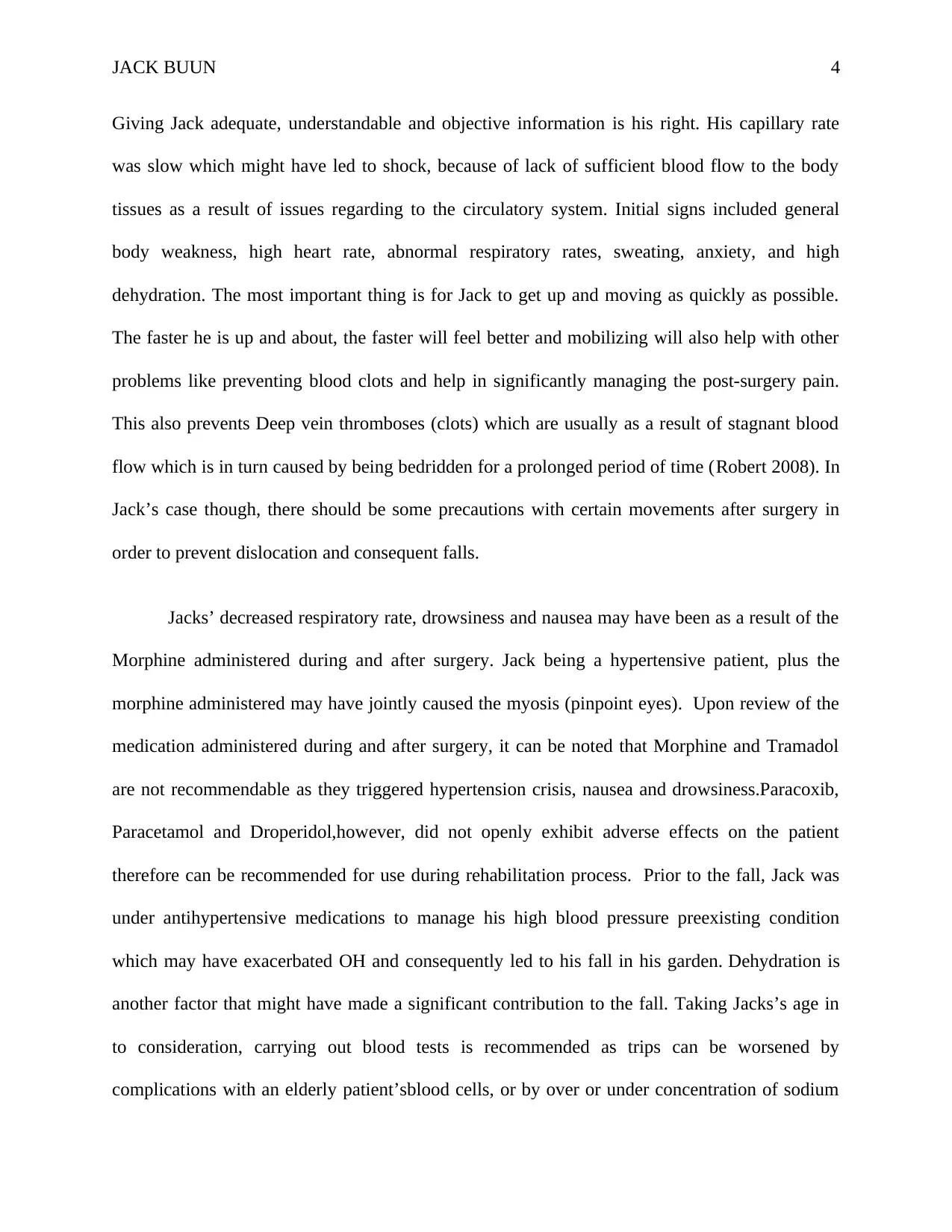
JACK BUUN 4
Giving Jack adequate, understandable and objective information is his right. His capillary rate
was slow which might have led to shock, because of lack of sufficient blood flow to the body
tissues as a result of issues regarding to the circulatory system. Initial signs included general
body weakness, high heart rate, abnormal respiratory rates, sweating, anxiety, and high
dehydration. The most important thing is for Jack to get up and moving as quickly as possible.
The faster he is up and about, the faster will feel better and mobilizing will also help with other
problems like preventing blood clots and help in significantly managing the post-surgery pain.
This also prevents Deep vein thromboses (clots) which are usually as a result of stagnant blood
flow which is in turn caused by being bedridden for a prolonged period of time (Robert 2008). In
Jack’s case though, there should be some precautions with certain movements after surgery in
order to prevent dislocation and consequent falls.
Jacks’ decreased respiratory rate, drowsiness and nausea may have been as a result of the
Morphine administered during and after surgery. Jack being a hypertensive patient, plus the
morphine administered may have jointly caused the myosis (pinpoint eyes). Upon review of the
medication administered during and after surgery, it can be noted that Morphine and Tramadol
are not recommendable as they triggered hypertension crisis, nausea and drowsiness.Paracoxib,
Paracetamol and Droperidol,however, did not openly exhibit adverse effects on the patient
therefore can be recommended for use during rehabilitation process. Prior to the fall, Jack was
under antihypertensive medications to manage his high blood pressure preexisting condition
which may have exacerbated OH and consequently led to his fall in his garden. Dehydration is
another factor that might have made a significant contribution to the fall. Taking Jacks’s age in
to consideration, carrying out blood tests is recommended as trips can be worsened by
complications with an elderly patient’sblood cells, or by over or under concentration of sodium
Giving Jack adequate, understandable and objective information is his right. His capillary rate
was slow which might have led to shock, because of lack of sufficient blood flow to the body
tissues as a result of issues regarding to the circulatory system. Initial signs included general
body weakness, high heart rate, abnormal respiratory rates, sweating, anxiety, and high
dehydration. The most important thing is for Jack to get up and moving as quickly as possible.
The faster he is up and about, the faster will feel better and mobilizing will also help with other
problems like preventing blood clots and help in significantly managing the post-surgery pain.
This also prevents Deep vein thromboses (clots) which are usually as a result of stagnant blood
flow which is in turn caused by being bedridden for a prolonged period of time (Robert 2008). In
Jack’s case though, there should be some precautions with certain movements after surgery in
order to prevent dislocation and consequent falls.
Jacks’ decreased respiratory rate, drowsiness and nausea may have been as a result of the
Morphine administered during and after surgery. Jack being a hypertensive patient, plus the
morphine administered may have jointly caused the myosis (pinpoint eyes). Upon review of the
medication administered during and after surgery, it can be noted that Morphine and Tramadol
are not recommendable as they triggered hypertension crisis, nausea and drowsiness.Paracoxib,
Paracetamol and Droperidol,however, did not openly exhibit adverse effects on the patient
therefore can be recommended for use during rehabilitation process. Prior to the fall, Jack was
under antihypertensive medications to manage his high blood pressure preexisting condition
which may have exacerbated OH and consequently led to his fall in his garden. Dehydration is
another factor that might have made a significant contribution to the fall. Taking Jacks’s age in
to consideration, carrying out blood tests is recommended as trips can be worsened by
complications with an elderly patient’sblood cells, or by over or under concentration of sodium
Paraphrase This Document
Need a fresh take? Get an instant paraphrase of this document with our AI Paraphraser
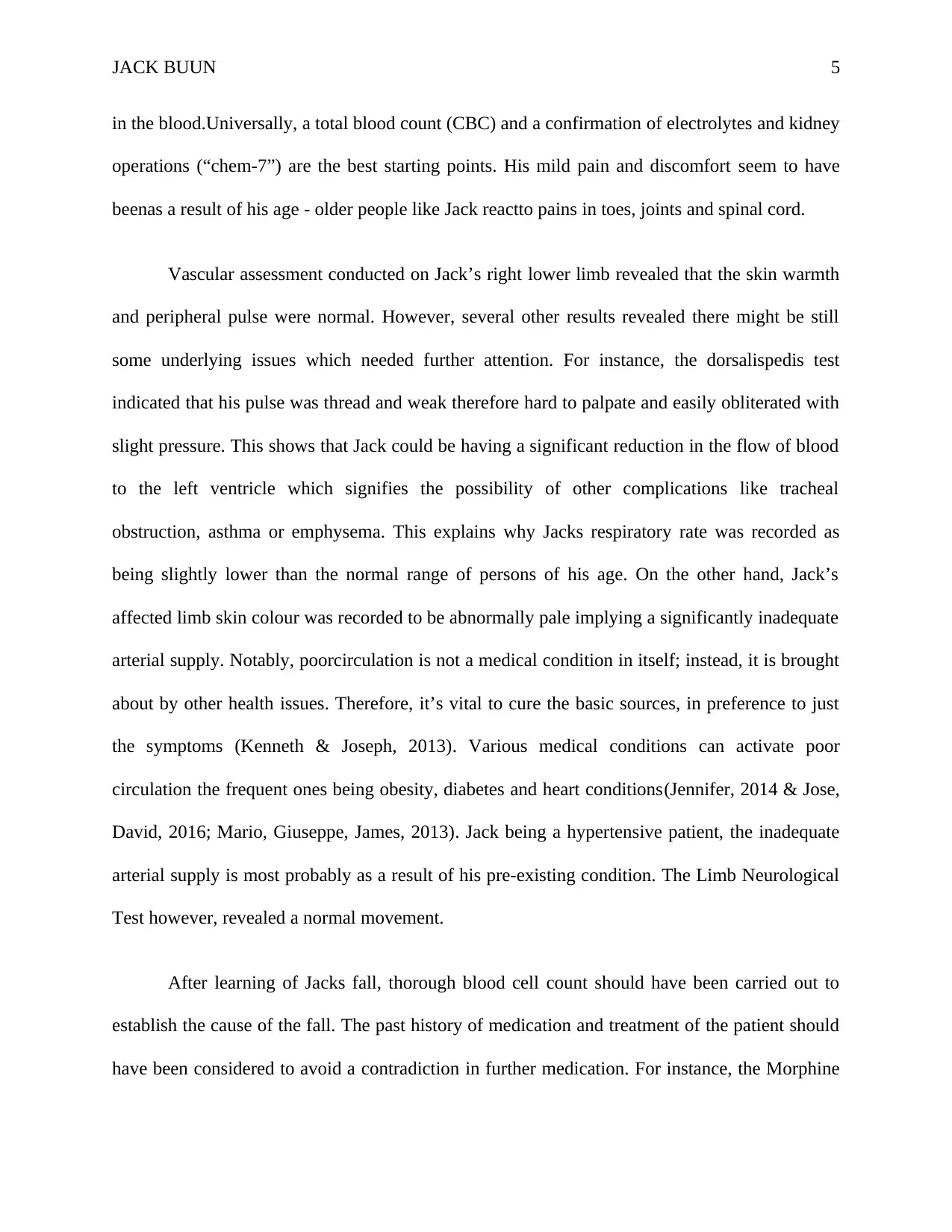
JACK BUUN 5
in the blood.Universally, a total blood count (CBC) and a confirmation of electrolytes and kidney
operations (“chem-7”) are the best starting points. His mild pain and discomfort seem to have
beenas a result of his age - older people like Jack reactto pains in toes, joints and spinal cord.
Vascular assessment conducted on Jack’s right lower limb revealed that the skin warmth
and peripheral pulse were normal. However, several other results revealed there might be still
some underlying issues which needed further attention. For instance, the dorsalispedis test
indicated that his pulse was thread and weak therefore hard to palpate and easily obliterated with
slight pressure. This shows that Jack could be having a significant reduction in the flow of blood
to the left ventricle which signifies the possibility of other complications like tracheal
obstruction, asthma or emphysema. This explains why Jacks respiratory rate was recorded as
being slightly lower than the normal range of persons of his age. On the other hand, Jack’s
affected limb skin colour was recorded to be abnormally pale implying a significantly inadequate
arterial supply. Notably, poorcirculation is not a medical condition in itself; instead, it is brought
about by other health issues. Therefore, it’s vital to cure the basic sources, in preference to just
the symptoms (Kenneth & Joseph, 2013). Various medical conditions can activate poor
circulation the frequent ones being obesity, diabetes and heart conditions(Jennifer, 2014 & Jose,
David, 2016; Mario, Giuseppe, James, 2013). Jack being a hypertensive patient, the inadequate
arterial supply is most probably as a result of his pre-existing condition. The Limb Neurological
Test however, revealed a normal movement.
After learning of Jacks fall, thorough blood cell count should have been carried out to
establish the cause of the fall. The past history of medication and treatment of the patient should
have been considered to avoid a contradiction in further medication. For instance, the Morphine
in the blood.Universally, a total blood count (CBC) and a confirmation of electrolytes and kidney
operations (“chem-7”) are the best starting points. His mild pain and discomfort seem to have
beenas a result of his age - older people like Jack reactto pains in toes, joints and spinal cord.
Vascular assessment conducted on Jack’s right lower limb revealed that the skin warmth
and peripheral pulse were normal. However, several other results revealed there might be still
some underlying issues which needed further attention. For instance, the dorsalispedis test
indicated that his pulse was thread and weak therefore hard to palpate and easily obliterated with
slight pressure. This shows that Jack could be having a significant reduction in the flow of blood
to the left ventricle which signifies the possibility of other complications like tracheal
obstruction, asthma or emphysema. This explains why Jacks respiratory rate was recorded as
being slightly lower than the normal range of persons of his age. On the other hand, Jack’s
affected limb skin colour was recorded to be abnormally pale implying a significantly inadequate
arterial supply. Notably, poorcirculation is not a medical condition in itself; instead, it is brought
about by other health issues. Therefore, it’s vital to cure the basic sources, in preference to just
the symptoms (Kenneth & Joseph, 2013). Various medical conditions can activate poor
circulation the frequent ones being obesity, diabetes and heart conditions(Jennifer, 2014 & Jose,
David, 2016; Mario, Giuseppe, James, 2013). Jack being a hypertensive patient, the inadequate
arterial supply is most probably as a result of his pre-existing condition. The Limb Neurological
Test however, revealed a normal movement.
After learning of Jacks fall, thorough blood cell count should have been carried out to
establish the cause of the fall. The past history of medication and treatment of the patient should
have been considered to avoid a contradiction in further medication. For instance, the Morphine
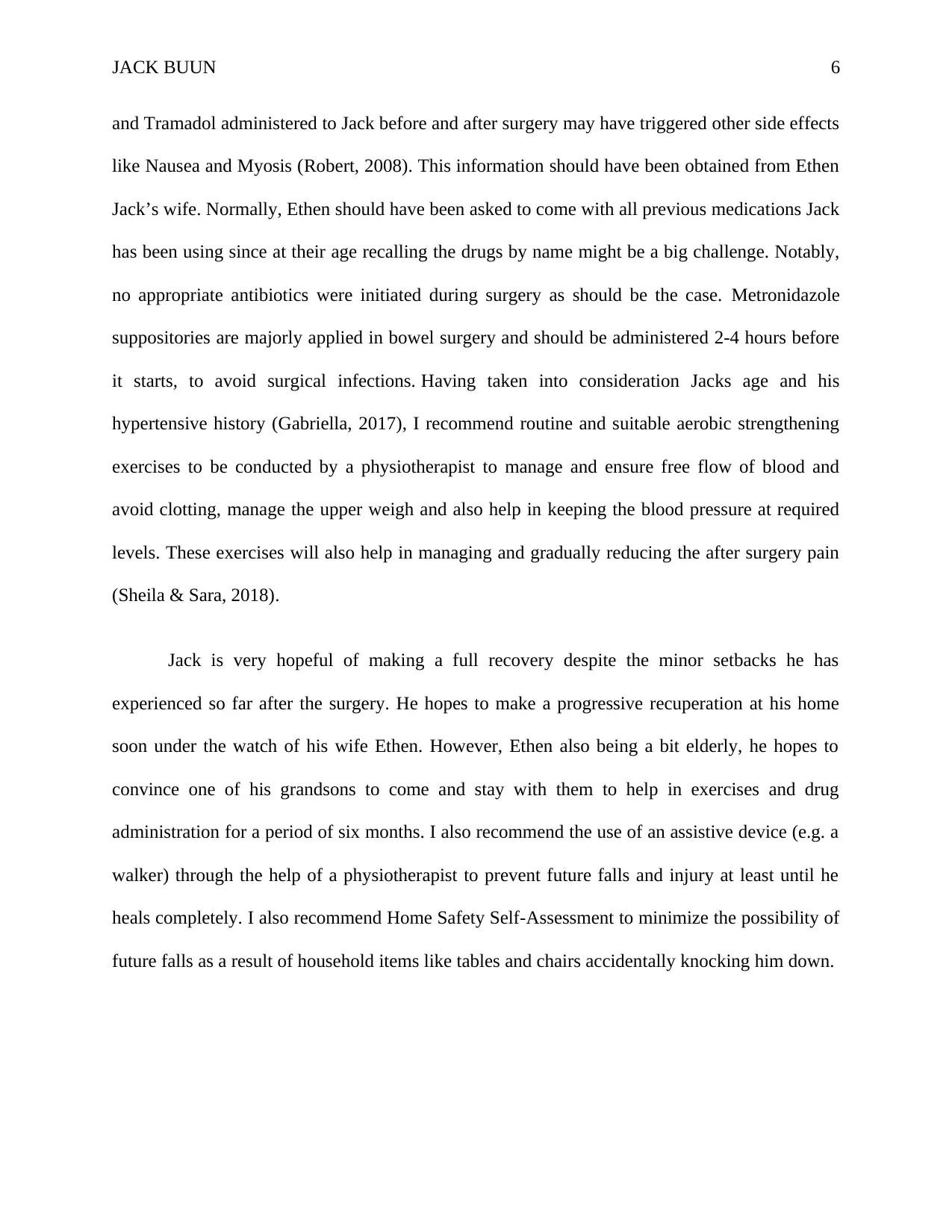
JACK BUUN 6
and Tramadol administered to Jack before and after surgery may have triggered other side effects
like Nausea and Myosis (Robert, 2008). This information should have been obtained from Ethen
Jack’s wife. Normally, Ethen should have been asked to come with all previous medications Jack
has been using since at their age recalling the drugs by name might be a big challenge. Notably,
no appropriate antibiotics were initiated during surgery as should be the case. Metronidazole
suppositories are majorly applied in bowel surgery and should be administered 2-4 hours before
it starts, to avoid surgical infections. Having taken into consideration Jacks age and his
hypertensive history (Gabriella, 2017), I recommend routine and suitable aerobic strengthening
exercises to be conducted by a physiotherapist to manage and ensure free flow of blood and
avoid clotting, manage the upper weigh and also help in keeping the blood pressure at required
levels. These exercises will also help in managing and gradually reducing the after surgery pain
(Sheila & Sara, 2018).
Jack is very hopeful of making a full recovery despite the minor setbacks he has
experienced so far after the surgery. He hopes to make a progressive recuperation at his home
soon under the watch of his wife Ethen. However, Ethen also being a bit elderly, he hopes to
convince one of his grandsons to come and stay with them to help in exercises and drug
administration for a period of six months. I also recommend the use of an assistive device (e.g. a
walker) through the help of a physiotherapist to prevent future falls and injury at least until he
heals completely. I also recommend Home Safety Self-Assessment to minimize the possibility of
future falls as a result of household items like tables and chairs accidentally knocking him down.
and Tramadol administered to Jack before and after surgery may have triggered other side effects
like Nausea and Myosis (Robert, 2008). This information should have been obtained from Ethen
Jack’s wife. Normally, Ethen should have been asked to come with all previous medications Jack
has been using since at their age recalling the drugs by name might be a big challenge. Notably,
no appropriate antibiotics were initiated during surgery as should be the case. Metronidazole
suppositories are majorly applied in bowel surgery and should be administered 2-4 hours before
it starts, to avoid surgical infections. Having taken into consideration Jacks age and his
hypertensive history (Gabriella, 2017), I recommend routine and suitable aerobic strengthening
exercises to be conducted by a physiotherapist to manage and ensure free flow of blood and
avoid clotting, manage the upper weigh and also help in keeping the blood pressure at required
levels. These exercises will also help in managing and gradually reducing the after surgery pain
(Sheila & Sara, 2018).
Jack is very hopeful of making a full recovery despite the minor setbacks he has
experienced so far after the surgery. He hopes to make a progressive recuperation at his home
soon under the watch of his wife Ethen. However, Ethen also being a bit elderly, he hopes to
convince one of his grandsons to come and stay with them to help in exercises and drug
administration for a period of six months. I also recommend the use of an assistive device (e.g. a
walker) through the help of a physiotherapist to prevent future falls and injury at least until he
heals completely. I also recommend Home Safety Self-Assessment to minimize the possibility of
future falls as a result of household items like tables and chairs accidentally knocking him down.
⊘ This is a preview!⊘
Do you want full access?
Subscribe today to unlock all pages.

Trusted by 1+ million students worldwide
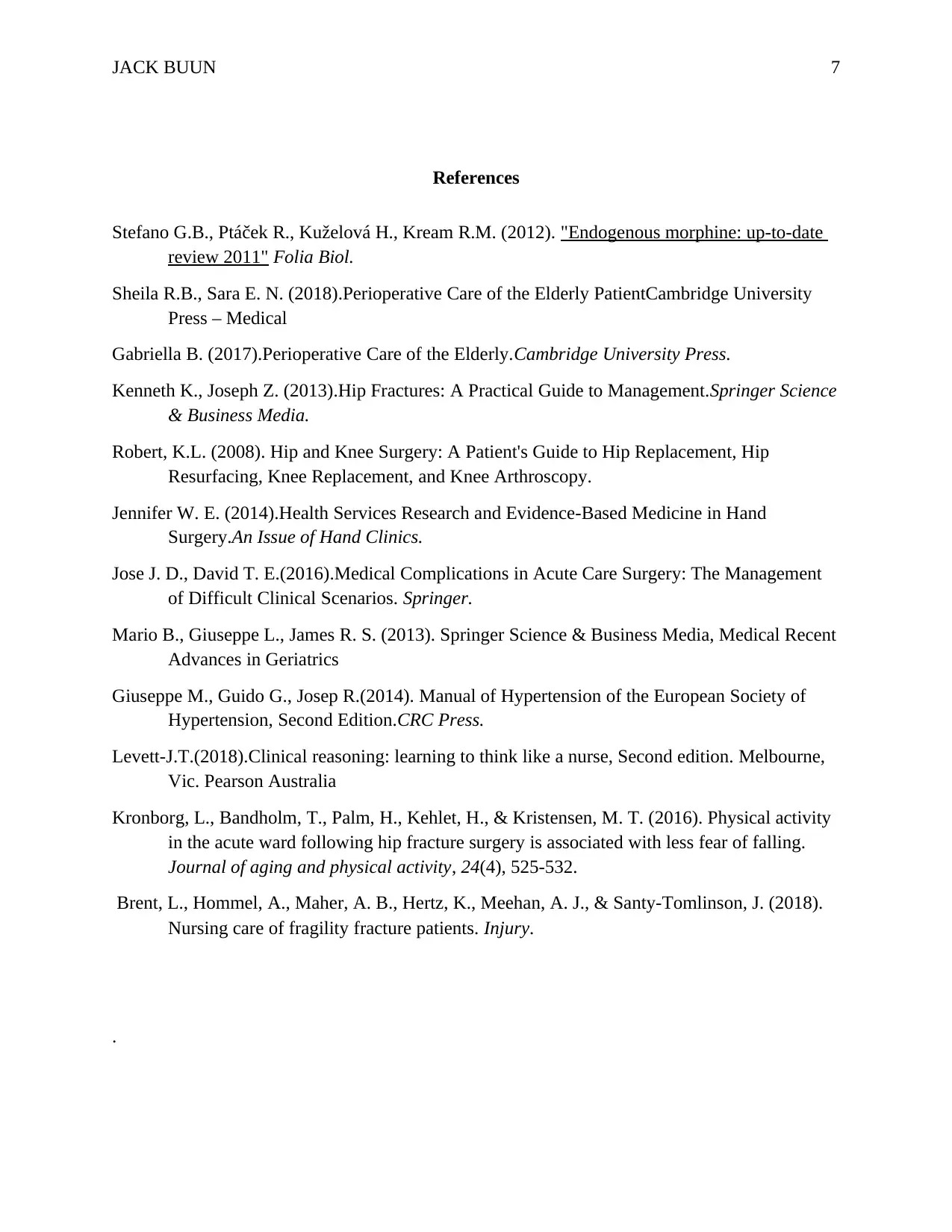
JACK BUUN 7
References
Stefano G.B., Ptáček R., Kuželová H., Kream R.M. (2012). "Endogenous morphine: up-to-date
review 2011" Folia Biol.
Sheila R.B., Sara E. N. (2018).Perioperative Care of the Elderly PatientCambridge University
Press – Medical
Gabriella B. (2017).Perioperative Care of the Elderly.Cambridge University Press.
Kenneth K., Joseph Z. (2013).Hip Fractures: A Practical Guide to Management.Springer Science
& Business Media.
Robert, K.L. (2008). Hip and Knee Surgery: A Patient's Guide to Hip Replacement, Hip
Resurfacing, Knee Replacement, and Knee Arthroscopy.
Jennifer W. E. (2014).Health Services Research and Evidence-Based Medicine in Hand
Surgery.An Issue of Hand Clinics.
Jose J. D., David T. E.(2016).Medical Complications in Acute Care Surgery: The Management
of Difficult Clinical Scenarios. Springer.
Mario B., Giuseppe L., James R. S. (2013). Springer Science & Business Media, Medical Recent
Advances in Geriatrics
Giuseppe M., Guido G., Josep R.(2014). Manual of Hypertension of the European Society of
Hypertension, Second Edition.CRC Press.
Levett-J.T.(2018).Clinical reasoning: learning to think like a nurse, Second edition. Melbourne,
Vic. Pearson Australia
Kronborg, L., Bandholm, T., Palm, H., Kehlet, H., & Kristensen, M. T. (2016). Physical activity
in the acute ward following hip fracture surgery is associated with less fear of falling.
Journal of aging and physical activity, 24(4), 525-532.
Brent, L., Hommel, A., Maher, A. B., Hertz, K., Meehan, A. J., & Santy-Tomlinson, J. (2018).
Nursing care of fragility fracture patients. Injury.
.
References
Stefano G.B., Ptáček R., Kuželová H., Kream R.M. (2012). "Endogenous morphine: up-to-date
review 2011" Folia Biol.
Sheila R.B., Sara E. N. (2018).Perioperative Care of the Elderly PatientCambridge University
Press – Medical
Gabriella B. (2017).Perioperative Care of the Elderly.Cambridge University Press.
Kenneth K., Joseph Z. (2013).Hip Fractures: A Practical Guide to Management.Springer Science
& Business Media.
Robert, K.L. (2008). Hip and Knee Surgery: A Patient's Guide to Hip Replacement, Hip
Resurfacing, Knee Replacement, and Knee Arthroscopy.
Jennifer W. E. (2014).Health Services Research and Evidence-Based Medicine in Hand
Surgery.An Issue of Hand Clinics.
Jose J. D., David T. E.(2016).Medical Complications in Acute Care Surgery: The Management
of Difficult Clinical Scenarios. Springer.
Mario B., Giuseppe L., James R. S. (2013). Springer Science & Business Media, Medical Recent
Advances in Geriatrics
Giuseppe M., Guido G., Josep R.(2014). Manual of Hypertension of the European Society of
Hypertension, Second Edition.CRC Press.
Levett-J.T.(2018).Clinical reasoning: learning to think like a nurse, Second edition. Melbourne,
Vic. Pearson Australia
Kronborg, L., Bandholm, T., Palm, H., Kehlet, H., & Kristensen, M. T. (2016). Physical activity
in the acute ward following hip fracture surgery is associated with less fear of falling.
Journal of aging and physical activity, 24(4), 525-532.
Brent, L., Hommel, A., Maher, A. B., Hertz, K., Meehan, A. J., & Santy-Tomlinson, J. (2018).
Nursing care of fragility fracture patients. Injury.
.
1 out of 7
Related Documents
Your All-in-One AI-Powered Toolkit for Academic Success.
+13062052269
info@desklib.com
Available 24*7 on WhatsApp / Email
![[object Object]](/_next/static/media/star-bottom.7253800d.svg)
Unlock your academic potential
Copyright © 2020–2025 A2Z Services. All Rights Reserved. Developed and managed by ZUCOL.





